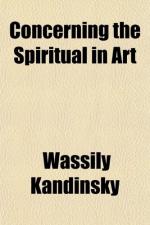Of course colour-music is no new idea. That is to say attempts have been made to play compositions in colour, by flashes and harmonies. [Footnote: Cf. “Colour Music,” by A. Wallace Rimington. Hutchinson. 6s. net.] Also music has been interpreted in colour. But I do not know of any previous attempt to paint, without any reference to music, compositions which shall have on the spectator an effect wholly divorced from representative association. Kandinsky refers to attempts to paint in colour-counterpoint. But that is a different matter, in that it is the borrowing from one art by another of purely technical methods, without a previous impulse from spiritual sympathy.
One is faced then with the conflicting claims of Picasso and Kandinsky to the position of true leader of non-representative art. Picasso’s admirers hail him, just as this Introduction hails Kandinsky, as a visual musician. The methods and ideas of each rival are so different that the title cannot be accorded to both. In his book, Kandinsky states his opinion of Cubism and its fatal weakness, and history goes to support his contention. The origin of Cubism in Cezanne, in a structural art that owes its very existence to matter, makes its claim to pure emotionalism seem untenable. Emotions are not composed of strata and conflicting pressures. Once abandon reality and the geometrical vision becomes abstract mathematics. It seems to me that Picasso shares a Futurist error when he endeavours to harmonize one item of reality—a number, a button, a few capital letters—with a surrounding aura of angular projections. There must be a conflict of impressions, which differ essentially in quality. One trend of modern music is towards realism of sound. Children cry, dogs bark, plates are broken. Picasso approaches the same goal from the opposite direction. It is as though he were trying to work from realism to music. The waste of time is, to my mind, equally complete in both cases. The power of music to give expression without the help of representation is its noblest possession. No painting has ever had such a precious power. Kandinsky is striving to give it that power, and prove what is at least the logical analogy between colour and sound, between line and rhythm of beat. Picasso makes little use of colour, and confines himself only to one series of line effects—those caused by conflicting angles. So his aim is smaller and more limited than Kandinsky’s even if it is as reasonable. But because it has not wholly abandoned realism but uses for the painting of feeling a structural vision dependent for its value on the association of reality, because in so doing it tries to make the best of two worlds, there seems little hope for it of redemption in either.




